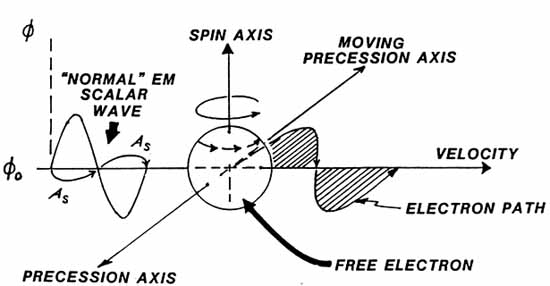On this slide I show the effects of precession of an electron when it
encounters a longitudinal scalar wave that contains "spin vortex
holes" for the electrons to fall into and mesh its spin with.
The basic
idea here -- that electron precession accounts for the Hertzian waves in
the electron gas in a transmitting antenna and in a receiving antenna,
came from my close colleague and friend, Frank Golden, and I am most
happy to give him full credit for this important insight.
As we have
previously stated, transverse (force) waves cannot exist in vacuum in
the absence of mass. Hertz waves therefore cannot
exist in vacuum, just as Tesla stated.
Yet we know
that Hertz waves exist in the electron gas in
our transmitting antennas and in the electron gas in our receiving
antennas. How then do we get Hertz waves here, if only
longitudinal waves can exist in the vacuum in between?
Electron
precession is the key.
We never
measure what's happening in vacuum with our instruments. Instead,
almost always we measure what is happening to and in the electron gas in
our antenna or probe and feeding current to the instrument.
Here we show
a "normal" EM vacuum wave -- which is a longitudinal wave
containing spin vortexes from the electrons that generated it --
approaching and striking a spinning charged electron. As the peak
and trough of the wave passes, it is as if we had a force pressing
against the spinning electron, first along the line of wave travel, and
then antiparallel to the wave travel. (that is,
"explaining" it in present concepts.)
The
electron acts as a little gyroscope, and precesses laterally, first in
one direction and then the other.
Therefore
the wave recovered in the electron gas in our receiving antenna or
instrument probe is a transverse Hertzian matter wave.
Hertz waves
are always matter vector waves.
Vacuum EM
waves are always nonmaterial longitudinal scalar waves.
Longitudinal
scalar waves in vacuum normally contain many spinning vortex
"holes" of flux, created from the spinning electrons which
launched the wave and stayed behind in the transmitting antenna.
This kind of longitudinal wave is directly detectable by a normal free
electron charged gas in a receiving antenna or probe. It also
directly interacts with free electrons in a conducting metal shield, and
so is shielded by Faraday cages.
On the other
hand, our zero-vector longitudinal wave, made
by opposing waves, contains opposing spin holes which annihilate or
cancel each other.
In the
absence of spin holes, the longitudinal wave will not mesh with spinning
electrons in a conductor, and so it is not detectable in the normal
fashion. It also does not interact with free electrons in a
conducting metal shield, so it readily penetrates Faraday cages.
An easy way
to see that electrons do not interact with that substructured
longitudinal zero-vector wave is to visualize both substructure
component waves interacting on the electron simultaneously, pushing in
opposite directions equally. In that case the electron tries to
precess in both directions, equally, and so it does not precess in
either direction. Therefore it does not "detect" the
passing wave.
The wave
without "golf ball holes", however, is detectable
by any circuit having high nonlinearity actions occurring in it.
Such highly nonlinear dynamic areas act to provide a phase shifting
between the composite substructure waves. This phase shift results
in violation of the sum-zero condition, producing a "normal"
EM wave which deposits energy in the out-of-phase area.
From
the spin vortex "golf ball hole" concept, the out-of-phase
condition means that now we have an alternating preponderance of spin
holes, spinning first in one direction and then in the other. Thus
the electrons in the nonlinear, phase shift area are hooked and
oscillated (precessed) to and fro, producing energy.
Solid
state, highly doped transistors are particularly vulnerable to this
effect, as are gas discharge tubes, spark and cascade ion discharges,
plasmas, etc.
Next Slide
|

